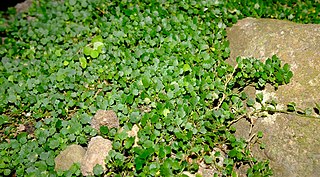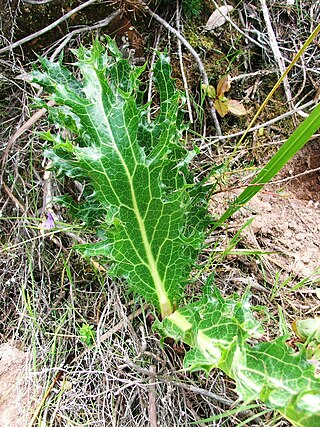
Agathosma is a genus of about 140 species of flowering plants in the family Rutaceae, native to the southern part of Africa. Common names include buchu, boegoe, bucco, bookoo and diosma. Buchu formally denotes two herbal species, prized for their fragrance and medicinal use despite their toxicity. In colloquial use however, the term is applied to a wider set of fragrant shrubs or substitutes.

Heliophila is a genus of flowering plants in the family Brassicaceae. Members of this genus are either annuals or perennials and some are popular as ornamental plants. Endemic to southern Africa, the majority of the approximately 80 species grow in South Africa, particularly the Cape Floristic Region, while a few extend into the Namib Desert.
Anginon is a genus of flowering plant in the family Apiaceae. It is endemic to southern Africa.

Phylica is a genus of plants in the family Rhamnaceae. It contains about 150 species, the majority of which are restricted to South Africa, where they form part of the fynbos. A few species occur in other parts of southern Africa, and on islands including Madagascar, the Mascarene Islands, Île Amsterdam, Saint Helena, Tristan da Cunha, and Gough Island. The oldest fossils of the genus are of Phylica piloburmensis from the Burmese amber of Myanmar, dating to around 99 million years ago during the mid-Cretaceous.

Poupartia is a genus of plant in family Anacardiaceae. From the islands of Madagascar, Mauritius, Rodrigues and Réunion, all in the Indian Ocean.

Coleonema is a genus of flowering plants in the family Rutaceae. The eight known species are all from the western Cape Province of South Africa. In Australia, where they are cultivated as garden ornamentals, they are often referred to as Diosma, a different genus in the same family.

Pourthiaea is a genus of plants in the rose family (Rosaceae).

Hermannia is a genus of flowering plants in the mallow family, Malvaceae. It comprises at least 65 species with many more species as yet unresolved.

Penaea is a genus of flowering plants in the family Penaeaceae, found in southern South Africa. They have an unusual type of embryo sac development; after two rounds of mitosis, four nuclei are formed at each pole, leading to a mature embryo sac containing four polar groups each with three cells. When found in other taxa, these embryo sacs are termed Penaea-type.
Acrosanthes is a genus of flowering plants in the family Aizoaceae. It is native to Southern Africa.

Wimmerella is a genus of flowering plants belonging to the family Campanulaceae. It is also in the Lobelioideae subfamily.
Audouinia is a genus of flowering plants belonging to the family Bruniaceae.
Dahliaphyllum is a genus of flowering plants in the family Apiaceae. Its sole species is Dahliaphyllum almedae, native to Southwestern Mexico.

Lichtensteinia is a genus of flowering plants belonging to the family Apiaceae. It is also the only genus in the tribe Lichtensteinieae, subfamily Apioideae.
Lundia is a genus of flowering plants belonging to the family Bignoniaceae.

Montinia is a monotypic genus of flowering plants belonging to the family Montiniaceae. It only contains one known species, Montinia caryophyllaceaThunb.
Ottosonderia is a genus of flowering plants belonging to the family Aizoaceae.











